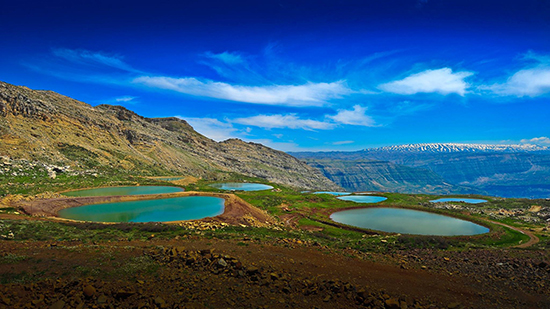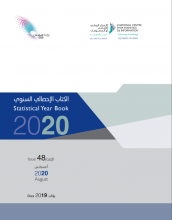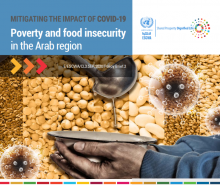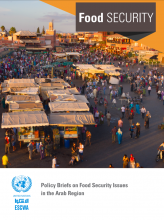Water and Food Security
The Arab region is one of the most water scarce and insecure regions in the world, dealing with uneven distribution of the increasingly critical resource. In most Arab countries, water has become a critical natural resource. Of the 22 Arab countries, 13 receive less than 251 mm of rainfall annually.[1] with nearly 362 million people experience conditions ranging from water scarcity to absolute scarcity.[2][3] Around 59.2 percent of the Arab population live in urban areas in 2019,[4] exerting additional pressure on the urban water infrastructure. The increasingly scarce and deteriorating water security conditions are affecting already existing challenges in the Arab region like food security, living conditions and human health.
With the spread of COVID–19, hand hygiene is essential and one of the best ways to contain the spread of the virus, as well as other infectious diseases, as per WHO hand washing guidelines.[5] In many parts of the Arab region, children, parents, health workers and other members of the community lack access to basic hand washing facilities like running water. The unequal distribution is more apparent in rural areas where 78 percent of people use at least basic drinking water services, as opposed to 94.4 percent in urban areas according to the latest available data.[6]
According to the WHO/UNICEF Joint Monitoring Programme (JMP) for Water Supply and Sanitation, the proportion of population accessing safely managed drinking water services varied at the regional level from 100 and 99 percent in countries such as Kuwait and Bahrain to 48 percent in Lebanon, according to latest available data.[7][8] On the other hand, the proportion of population accessing safely managed sanitation facilities ranged between 100 percent in Kuwait to 17.7 percent in Algeria and 21.8 percent in Lebanon.[7][9] Open defecation is still practiced in some countries in the region, as in Mauritania at 32 percent, Somalia at 27.5 percent and Sudan 24.3.[7]
The region continues to face low agricultural productivity, due to limited economic resources, limited investment in technologies, limited crop patterns and climate change implications.[10] More specifically, crop productivity is considered low, with cereals yield amounting to 2,024 kg/ha in 2017, almost half the world average of 4,074 kg/ha.[6]
With the prevalence of protracted armed conflicts, scarcity of natural resources and recurrent droughts, more people and children have been facing the risk of undernourishment. In conflict-hit Yemen and Iraq, the prevalence of undernourishment levelled at 39 percent and 23.7 percent, respectively in 2018. According to latest available data on stunting (between 2013 and 2016), highest prevalence rates were found in Yemen at 46.4 percent and Sudan at 38.2 percent. Along the same lines, the highest prevalence rates of wasting were reported in Yemen and Sudan at 16.4 and 16.3 percent respectively.[6]
This overview has been updated by the ADP team based on latest available data as of November 2020.
Source:
[1] Food and Agriculture Organization of the United Nations (FAO). AQUASTAT Main Database. [Online] Available at: http://www.fao.org/nr/water/aquastat/data/query/index.html?lang=en [Accessed 25 November 2020].
[2] Population Division of the Department of Economic and Social Affairs of the United Nations Secretariat. 2019. World Population Prospects. [ONLINE] Available at:
https://population.un.org/wpp/Download/Standard/Population/ [Accessed 25 November 2020].
[3] United Nations Economic and Social Commission for West Asia. 2019. Moving towards water scarcity in the Arab region. [ONLINE] Available at: https://www.unescwa.org/publications/moving-towards-achieving-water-security-arab-region [Accessed 25 November 2020].
[4] Population Division of the Department of Economic and Social Affairs of the United Nations Secretariat. 2018. World Urbanization Prospects. [ONLINE] Available at:
https://population.un.org/wup/ [Accessed 25 November 2020].
[5] World Health Organization. 2020. Clean hands protection. [ONLINE] Available at: https://www.who.int/gpsc/clean_hands_protection/en/ [Accessed 25 November 2020].
[6] The World Bank. 2020. World Development Indicators. [ONLINE] Available at: http://datatopics.worldbank.org/world-development-indicators/ [Accessed 25 November 2020].
[7] The World Health Organization (WHO) and United Nations Children's Fund (UNICEF). 2019. WHO/UNICEF Joint Monitoring Programme. [Online] Available at:
https://washdata.org/data/household#!/ [Accessed 25 November 2020].
[8] WHO/UNICEF define a safely managed drinking water as an improved water source that is accessible on premises, available when needed and free from faecal and priority chemical contamination.
[9] Safely managed sanitation is defined by the WHO/UNICEF as the improved facilities which are not shared with other households and where excreta are safely disposed in situ or transported and treated off-site.
[10] Arab Forum for Environment and Development (AFED), 2017. Arab Environment in 10 years. [ONLINE] Available at:
http://www.afedonline.org/webreport2017/afedreport2017.htm [Accessed 25 November 2020].
Data Highlights
-
Renewable water resources per inhabitant in the Arab Region reached 650 m3 in 2014, compared to a World average of about 6,000 m3 per inhabitant, placing 13 out of 22 Arab countries in the category of severe water scarcity at less than 500 m3 per capita.




